What is Shiodare Cabbage?
Shiodare cabbage (塩だれキャベツ) is a beloved Japanese side dish featuring crisp cabbage coated in a flavorful salt-based sauce (shiodare in Japanese) infused with sesame oil, garlic, and other seasonings.
Often served as a refreshing palate cleanser at izakaya and yakiniku restaurants, this dish earns its reputation as an “endless” treat that diners can’t stop eating.
Beyond restaurants, it’s also a practical staple for home cooks too. Not only is it easy to make, but it’s also a tasty way to use up all that leftover cabbage in the fridge.

Visual Walkthrough & Tips
Here are my step-by-step instructions for how to make Shiodare Cabbage at home. For ingredient quantities and simplified instructions, scroll down for the Printable Recipe Card below.
This section aims to provide a comprehensive overview of the cooking steps and techniques with visuals. It also includes more in-depth tips and tricks and explains why I do what I do.
Tear the washed leaves into large bite-sized pieces instead of cutting them with a knife. Tearing it along the natural fibers creates uneven surfaces that better absorb the flavorful sauce.
Spring cabbage, cannon ball, and Danish ball head varieties work really well for this dish because of their tender leaves and sweet flavor.
Place the torn cabbage in a large bowl and sprinkle with salt. Using clean hands, gently massage the salt into the leaves.

When salt is applied to cabbage, it creates an osmotic pressure that draws water from the cells. This process is what gives shiodare cabbage its characteristic texture-still crisp but not too raw-tasting.
Let the salted cabbage rest for 10-15 minutes. Too short and the cabbage won’t release enough moisture, too long and it will become too soft and lose its refreshing crunch. You’ll know it’s ready when the cabbage volume has noticeably reduced and water has pooled at the bottom of the bowl.
While the cabbage is resting, make your shiodare sauce. In a small saucepan, mix together water, garlic paste, ground black pepper, fine sea salt, sugar, lemon juice, chicken bouillon powder, honey, and toasted sesame oil.

Heat the mixture over low heat and allow the sauce to simmer gently for about 2 minutes.

In a small bowl, create a slurry by thoroughly mixing potato starch with cold water until completely smooth.

Potato starch creates a glossy, transparent sauce with a silky mouthfeel and doesn’t cloud as it cools. Cornstarch is an excellent alternative, while tapioca starch provides a slightly more elastic texture. Avoid wheat flour, which would create an opaque sauce and require longer cooking to remove the raw flour taste.
Whisk the sauce continuously as you slowly pour in the slurry in a thin stream. This keeps lumps from forming. Keep stirring until the sauce gets a little thicker. You want it to coat the back of a spoon, but still flow easily, like maple syrup.
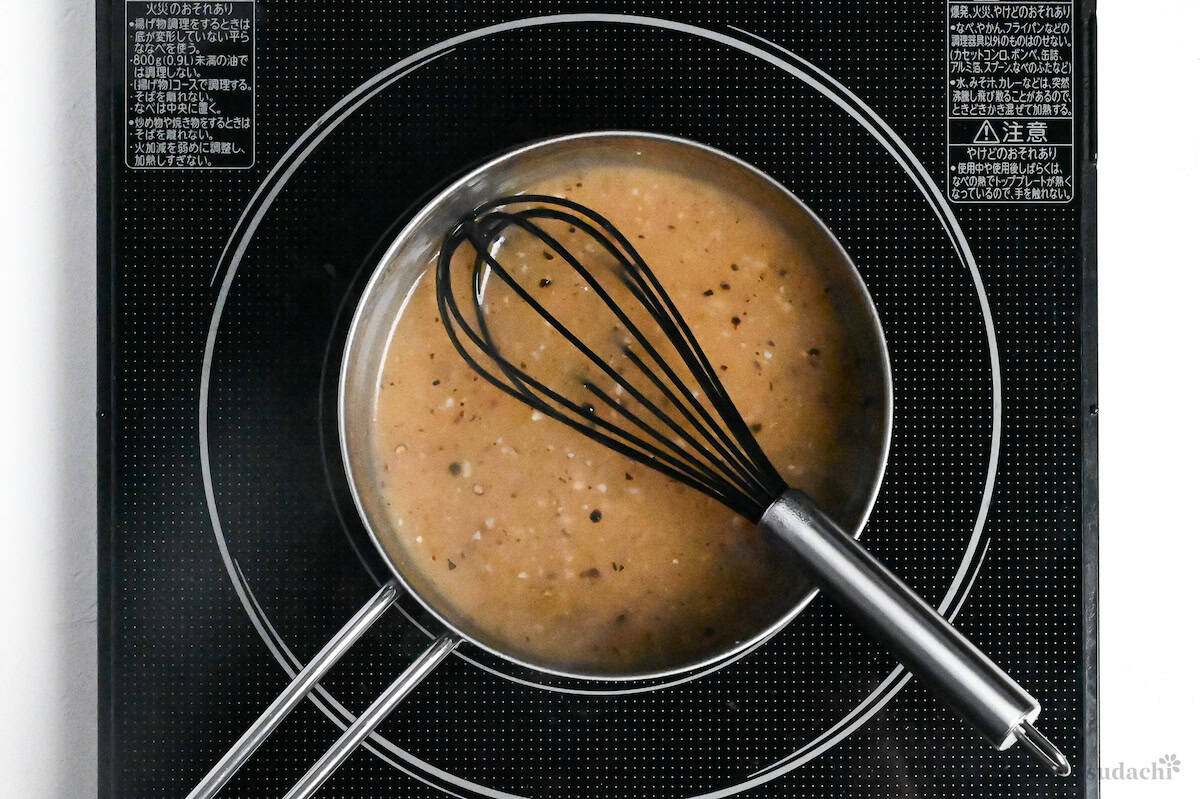
Once thickened, immediately remove from heat to prevent over-thickening. Set aside to cool slightly while you finish preparing the cabbage.
Go back to your salted cabbage, which should have released a significant amount of water by now. Gently, but firmly, squeeze the cabbage with your clean hands or a clean kitchen towel to get rid of the extra water.
No need to wash or rinse the cabbage here, just transfer it straight to a clean bowl. Pour the warm (not hot) sauce over the cabbage and, using clean hands or kitchen tongs, gently toss to ensure each piece is well coated.
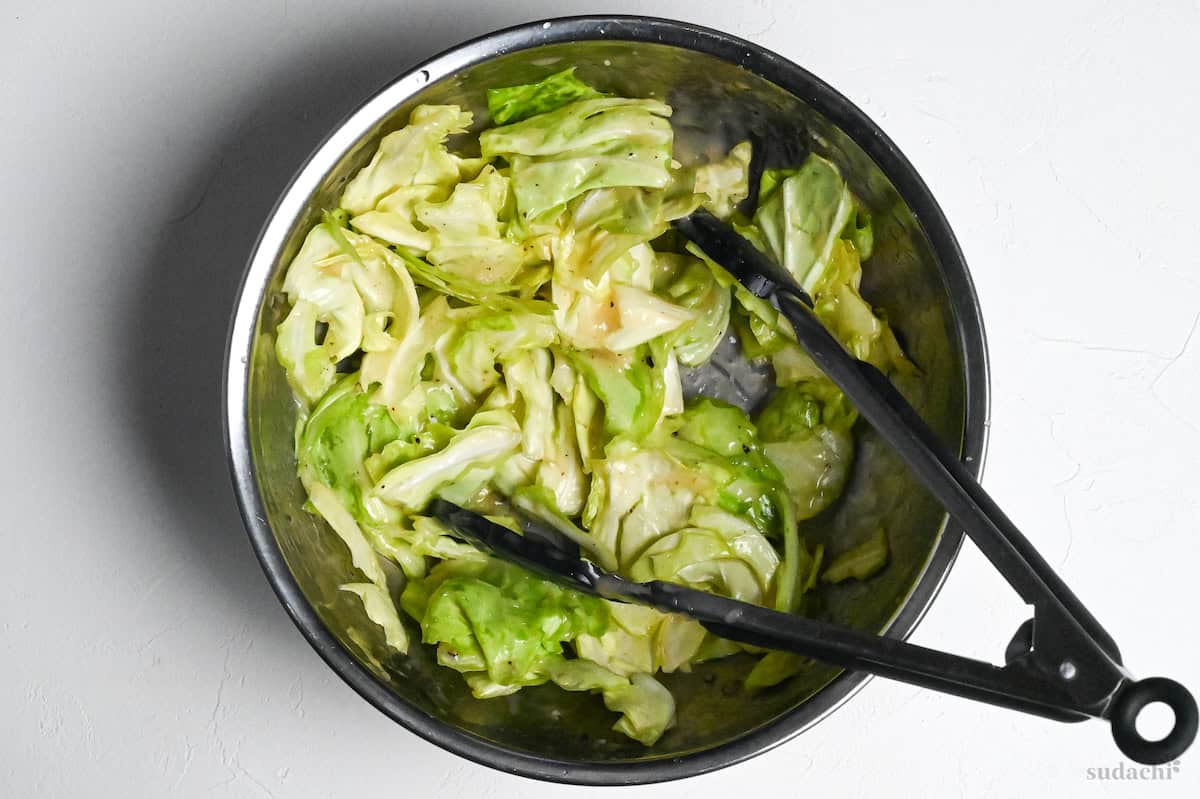
The slightly warm sauce will be absorbed more readily by the cabbage, enhancing flavor penetration.
The shiodare cabbage can be enjoyed immediately, but for best results, cover and refrigerate for at least 30 minutes. This resting period allows the flavors to fully develop and marry, resulting in a more complex taste profile.
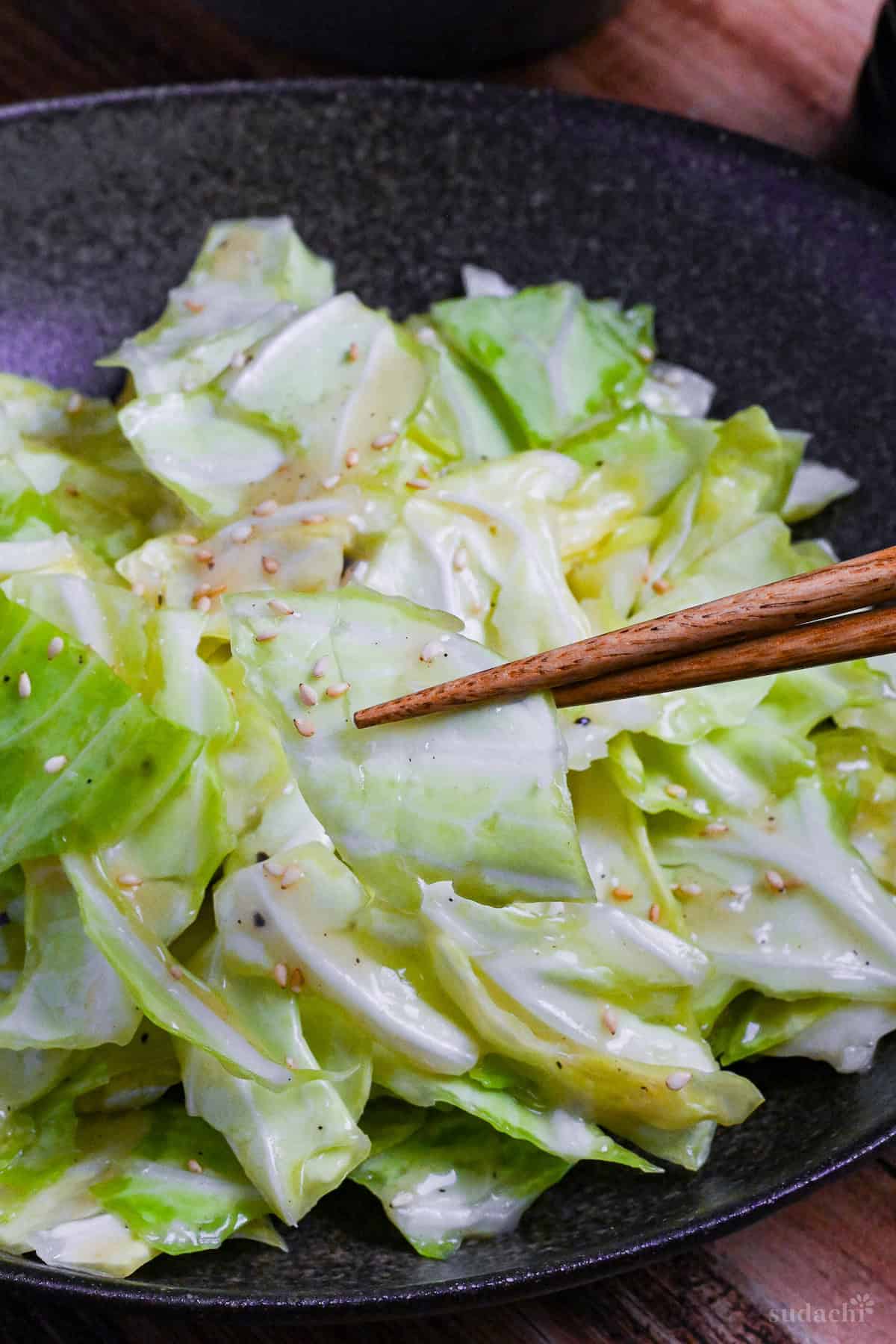
Just before serving, sprinkle with toasted sesame seeds.
Jump to Full Recipe MeasurementsEssential Tips & Tricks
- Tear, don’t cut the cabbage to create irregular surfaces that better absorb flavor.
- Salt for 10-15 minutes-too short and the moisture won’t release, too long and the cabbage becomes soggy.
- Squeeze thoroughly after salting-excess water will dilute your sauce and ruin the texture.
- Stop cooking once sauce coats the back of a spoon-over-thickening creates a gummy texture.
- Let rest in refrigerator for 30+ minutes before serving for flavors to fully develop.
With these simple tips in mind, you’re set for success every time you make Shiodare Cabbage.
Meal Prep & Storage
This shiodare cabbage recipe is excellent for meal prep!
- Full Dish Prep: Prepare the complete recipe through the final mixing stage, cool to room temperature, and refrigerate in airtight containers. The flavor reaches its peak around 24 hours after preparation as the cabbage fully absorbs the sauce compounds. Enjoy within 3 days for optimal texture and flavor.
- Component Prep: Make the shiodare sauce (without the starch slurry) up to 5 days ahead and store in the refrigerator. When ready to eat, heat the sauce gently, add the slurry to thicken, then toss with freshly salt-rubbed and drained cabbage.
- Cabbage Preparation: If you’re short on time, you can wash and tear the cabbage in advance.
For storage, keep shiodare cabbage in an airtight glass or plastic container in the refrigerator. It maintains its quality for 3-4 days, though the texture is at its best within the first 2 days.
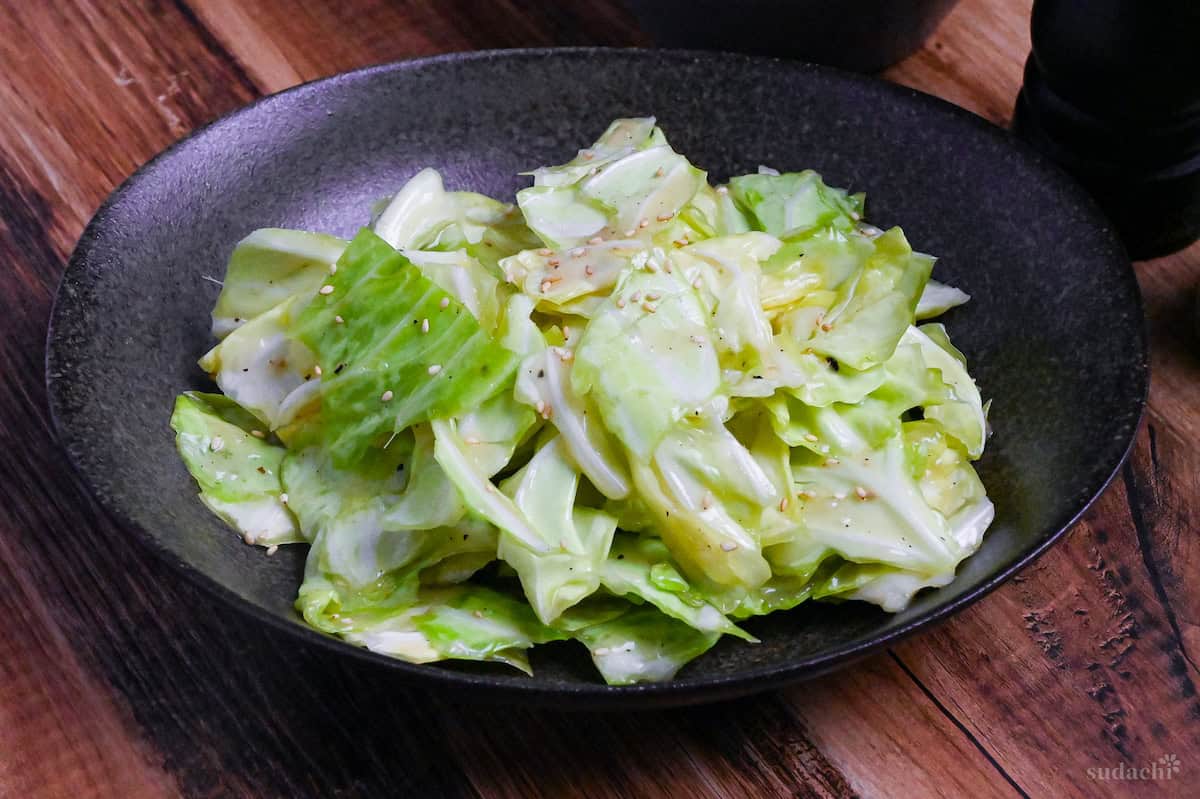
Serving Suggestions
FAQ
Here are answers to frequently asked questions I have received across all platforms, including here, YouTube, Instagram, and Pinterest. If you have any questions, feel free to send them to me anytime! It will be a big help for everyone in this community!
Yes, you can adapt this recipe for other vegetables. Cucumber works especially well.
Absolutely! Simply replace the chicken bouillon powder with vegetable stock powder or mushroom powder.
Definitely! The shiodare sauce is versatile and can be used as a dressing for other dishes. Check out my shiodare butadon recipe if you’re interested!
I hope you enjoy this recipe! If you try it out, I’d really appreciate it if you could spare a moment to let me know what you thought by giving a review and star rating in the comments below. It’s also helpful to share any adjustments you made to the recipe with our other readers. Thank you!
More Addictive Salad Recipes
- Izakaya’s Yamitsuki Smashed Cucumber Salad
- Addictive Izakaya Style Salted Cabbage
- Mugen “Infinite” Cabbage Salad
- Daikon Salad (Izakaya Style)
Hungry for more? Explore my yamitsuki recipe collection to find your next favorite dishes!
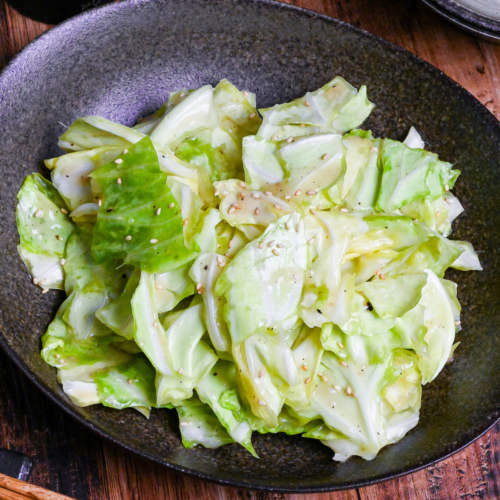
Shiodare Cabbage (Cabbage Salad with Addictive Salt Dressing)
Ingredients
- 300 g green cabbage soft leaf variety preferred (see note)
- 1 tsp salt to draw out moisture
- 4 tbsp water
- 1 tbsp toasted sesame oil
- 1 tsp Chinese-style chicken bouillon powder see notes for plant-based alternatives
- 1 tsp honey
- ½ tsp sugar or light brown sugar
- ½ tsp salt fine sea salt preferred, for sauce
- ½ tsp lemon juice
- ½ tsp garlic paste
- ¼ tsp ground black pepper
- 1 tbsp water to make slurry
- 1 tsp potato starch (katakuriko) or cornstarch, to make slurry
- toasted white sesame seeds to garnish
My recommended brands of ingredients and seasonings can be found in my Japanese pantry guide.
Can’t find certain Japanese ingredients? See my substitution guide here.
Instructions
- Take 300 g green cabbage and tear the leaves into large bitesize pieces into a large mixing bowl. Sprinkle with 1 tsp salt over the leaves and massage until evenly covered. Rest for 10-15 minutes.

- While you wait, take a small saucepan and add 4 tbsp water, 1 tbsp toasted sesame oil, 1 tsp Chinese-style chicken bouillon powder, 1 tsp honey, ½ tsp sugar, ½ tsp salt, ½ tsp lemon juice, ½ tsp garlic paste and ¼ tsp ground black pepper.

- Mix well and transfer the pot to the stove. Heat on low and gently simmer for about 2 minutes.

- Take a small bowl and mix 1 tbsp water and 1 tsp potato starch (katakuriko) together to make a slurry.

- Pour the slurry into the pot while whisking continuously. Keep stirring until the sauce has thickened slightly. Once it reaches the consistency of maple syrup, take the pot off of the stove and leave it to cool.

- Take the cabbage and gently squeeze to release excess water. Discard the water and place the cabbage in a clean bowl (no need to rinse or wash). Pour the warm (not hot) dressing over the cabbage and mix until evenly covered.

- If time permits, cover and refrigerate for 30 minutes before serving. Sprinkle with toasted white sesame seeds and enjoy!

Notes
- Green cabbage, spring cabbage, cannonball, and Danish ball work best for this recipe.
- For a vegetarian version, substitute mushroom powder or vegetable stock powder for chicken bouillon.
- Store in an airtight container for up to 4 days, with flavor peaking after 24 hours but optimal texture within the first 2 days.
- Serving suggestions: chicken yakitori, yakitori donburi, gyudon, oyakodon.
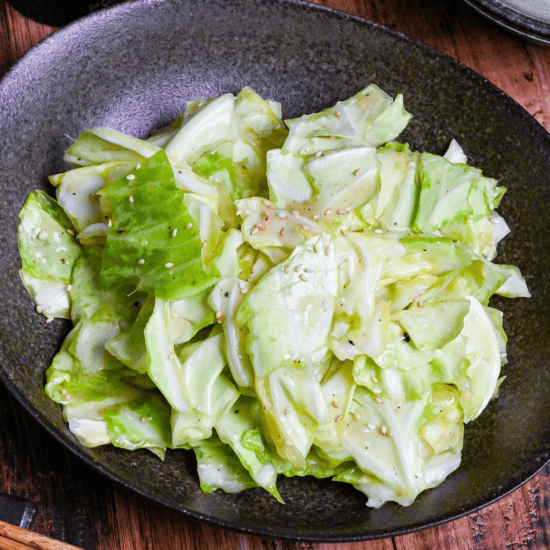


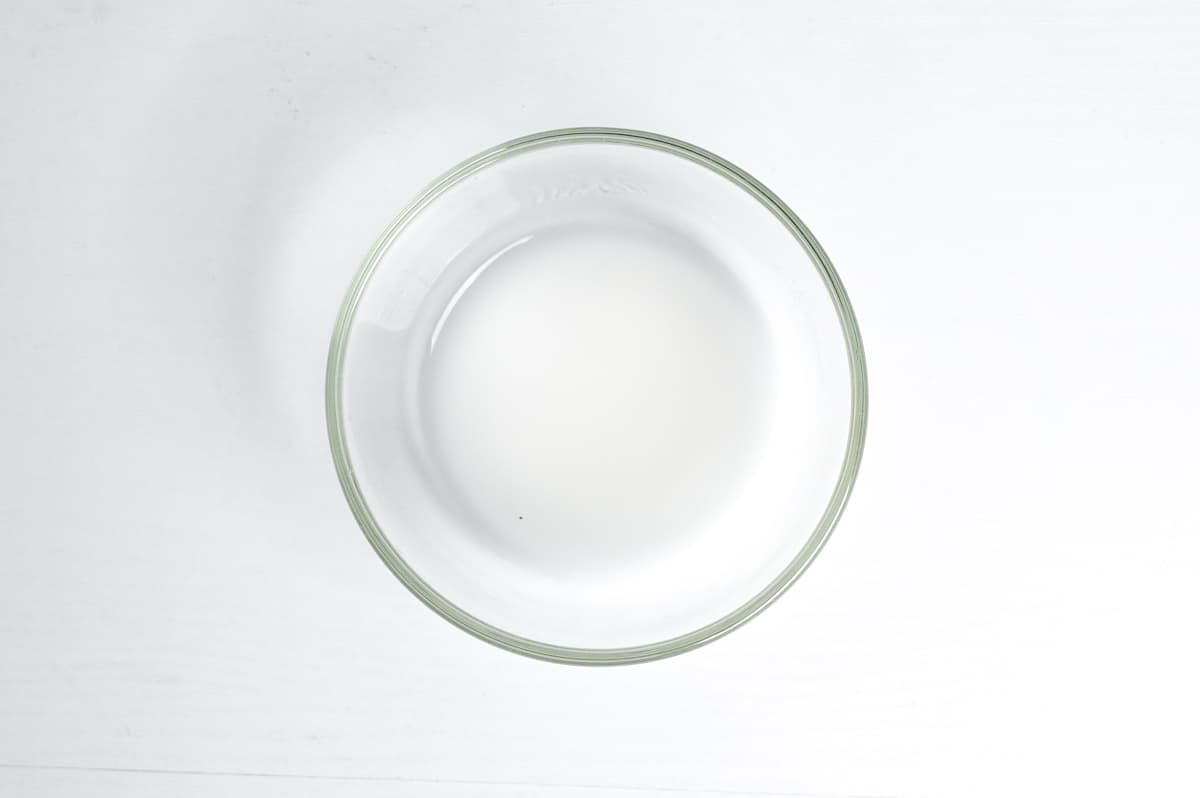

Do you need to rinse the salt off the cabbage before adding to sauce?
Hi Sine,
No need to rinse it, I’ve updated the recipe to make that clearer.
Thank you for pointing it out and I hope you enjoy the recipe!
Yuto